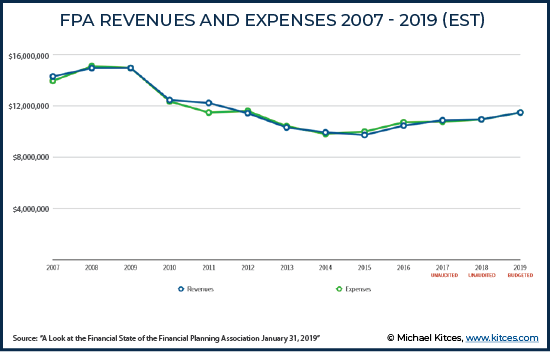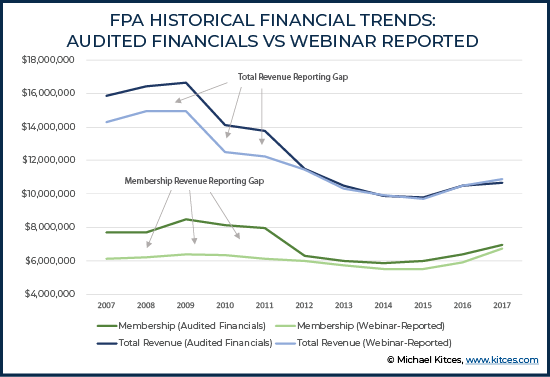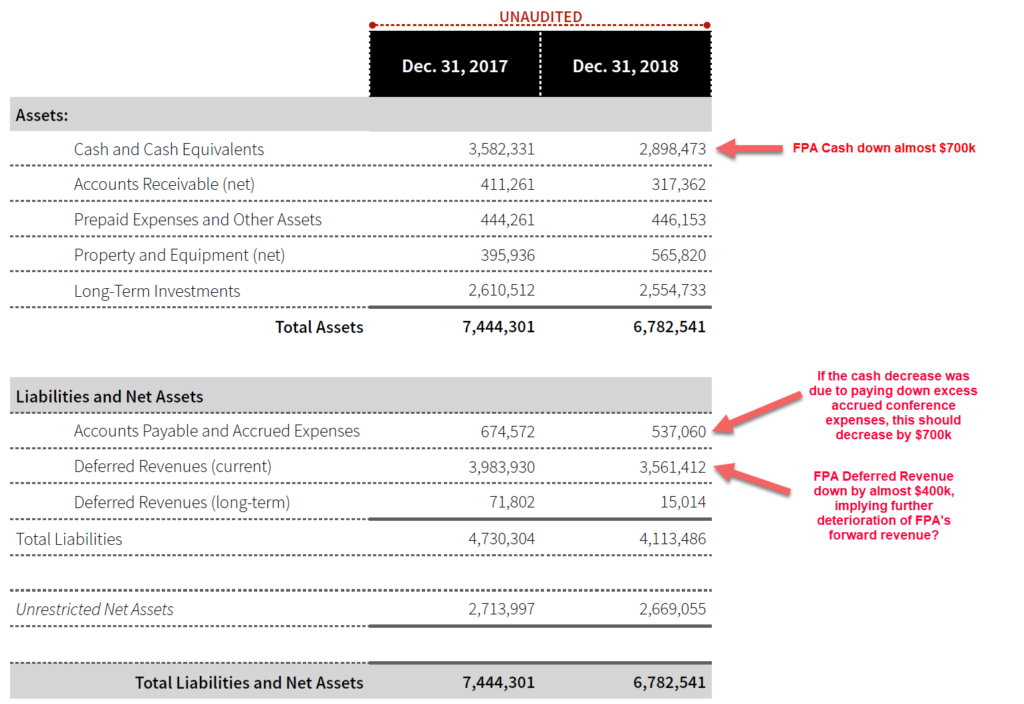Executive Summary
When the Financial Planning Association recently announced its OneFPA Network initiative to consolidate its chapters, a key aspect was to gain operational efficiencies and leverage the FPA’s economies of scale by fully centralizing the accounting of all 86 of its chapters. The systems overhaul would require a substantial initial investment – estimated at more than $300,000 – but with the end result of all chapters being relieved of the burden of chapter accounting and instead simply receiving monthly financial reports directly from National.
Yet part of the controversy of the OneFPA Network initiative is that FPA has been experiencing its own deterioration of financials over the past decade, with revenue down by millions of dollars since the financial crisis impacted the financial advisor community, raising questions of whether the FPA is simply trying to consolidate its chapters finances so it can get access to available chapter cash reserves and annual surpluses.
To rebut concerns about FPA’s financial state of affairs, the organization conducted in late January a first-ever “Overview of National Finances” to its chapter leaders, which did candidly acknowledge that the organization’s revenue has dropped by nearly $4M from a decade ago, but noting that membership revenue is actually up over that time period, and emphasizing that FPA’s finances have stabilized since the downturn. Except, as it turns out, the historical trends that the FPA presented didn’t even match its own published Audited Financials, to the tune of nearly $1.5M revenue per year for several years, and a cumulative mismatch of nearly $8M of 'missing' revenue over the past decade.
In addition, it’s notable that since 2015, the FPA stopped distributing its Audited Financials to members altogether – ironically a self-violation of the FPA’s own “Information and Transparency Policy” – and only began distributing a more limited financial summary in its Annual Report. Which itself was excluded from its just-released 2018 Annual Report, leaving FPA’s own membership entirely in the dark about its current financial state (except, again, for a recent webinar that reported numbers failing to match FPA’s already-published Audited Financials to the tune of $8M of missing revenue). Even as the webinar did concerningly highlight a substantial $700k drawdown in FPA’s available cash over the past year, which appears to be attributable primarily to a significant decrease in the FPA’s deferred revenue… a potential signal that its actual revenue is about to deteriorate further.
Fortunately, the reality is that the FPA does have a demonstrated track record of managing its expenses (i.e., cutting staff and costs) in-line with its revenue, and as a result, its available reserves have remained stable throughout its financial turmoil of the past decade. Which suggests that the FPA may not literally be in any kind of “financial distress,” but simply that the organization’s revenue is declining more substantially than it has previously implied… which should be a concern for a National Board that, thus far, has not held its staff leadership accountable for the decline.
More broadly, though, the key question is simply this: how can the FPA move forward with the OneFPA Network and confidently and transparently account for its chapters – which is at best an extremely time- and labor-intensive tasks when committed to monthly reconciled reporting – when the National organization can’t even effectively (and transparently) account for itself?
OneFPA Network Proposes To Expand (Monthly) Accounting To Chapters
As a large organization with over $10 million in annual revenues, the Financial Planning Association has a dedicated Director of Finance responsible for overseeing and managing the financials of the organization and maintaining financial controls. In turn, oversight is provided by an Audit Committee as a part of the National Board, with FPA’s financials audited annually by a third-party accounting firm (CapinCrouse).
As a membership association, this financial information is then made available to the membership as well. Historically, Audited Financials were sent annually directly to members, and FPA’s stated “Information and Transparency Policy” is that Audited Financial statements will also be available with the other Governing Documents posted to its website. In turn, Section 13.3 of the FPA’s Bylaws also state that any member may review the FPA’s Audited Financials at its home office in Denver. And of course, the FPA’s Form 990s are also public documents available through third-party services like Guidestar.
In fact, it’s these established systems and processes that FPA National has in place, plus its overall greater size and economies of scale, that were why FPA made the case in its recent OneFPA Network initiative that all chapter financials and accounting should be centralized to the National organization. As proposed, the FPA would maintain all chapter assets in a single centralized account, maintain tracking of finances for each chapter’s share of the assets and cash flows, and provide monthly reports (ostensibly after doing monthly reconciliations) to each chapter of its own revenue and expenses to they know where they stand financially.
Of course, the reality is that maintaining separate accounting for 86 different chapters – and what may literally be hundreds of people across all those chapters who may be collecting revenue, writing checks, or otherwise impacting the FPA’s cash flows – is a substantial increase in FPA’s accounting complexities. Which is why the FPA has set aside $303,000 to hire a third-party accounting firm called RSM to fully develop the additional layer of accounting systems this would require beyond what FPA National already has.
How Can FPA Account For Chapters When It Doesn’t Consistently Account For Itself
Notwithstanding the complexity challenge, though, the fundamental problem with FPA’s proposal to expand its accounting reach to its 86 chapters is that the organization does not actually have a good track record of accounting for itself to the membership in the first place.
For instance, despite having a policy of making its Audited Financials to members on its website, the FPA actually stopped distributing those reports to members after its 2015 Fiscal Year (and instead only began providing a more limited financial reporting to members in its Annual Report). Nor are its Audited Financials actually listed on its website; instead, the section labeled “Report to Members” under “Financials & Reports” just leads to a web page that has no historical Audited Financials, and no current Audited Financials. The only thing listed is the FPA’s latest Annual Report. And the FPA’s latest 2018 Annual Report, for the first time, doesn’t include any financial reporting there, either!
In turn, this noticeable decrease in FPA’s financial transparency to members in recent years has created concerns amongst members – including yours truly – that FPA is experiencing an increasing level of financial distress. After all, as reported previously here on Nerd’s Eye View, the FPA’s revenue is down nearly $6M over the past 10 years, including nearly $1.5M from lost dues as a result of declining membership, and an even-more-concerning $4.5M decrease in revenue from sponsorships, advertising, and conferences (based on its Audited Financials up through its 2017 Annual Report).
These concerns in turn prompted the FPA in late January to host its first ever “Overview of National Finances” webinar to chapter leaders (later made available to the general membership not on the FPA National website but at least on its separate OneFPA Network website), led by National Board Audit Committee Chair Skip Schweiss, to rebut any concerns about FPA’s financial health.
In the webinar (as well as in private meetings with chapter leaders during FPA’s virtual Listening Tour), the FPA emphasized that, while revenue has declined, the situation is not as severe as reported externally. Instead, the FPA webinar highlighted that FPA’s revenue has decreased by approximately $4M from a peak of $15M in 2008 and 2009, down to nearly $11M in 2018, but with membership revenue actually up slightly since its 2009 peak and corporate and conference revenue down “just” about $3.1M.

The problem, however, is that FPA’s own Audited Financials from 2008 show that membership revenue was $7.7M in 2008 and rose to $8.5M in 2009, before falling to $7.0M in its 2017 Annual Report. In other words, FPA’s own published financials don’t show membership revenue was up since its 2009 peak, but down $1.5M.
Of course, the reality is that accounting standards of what revenue is categorized where (e.g., if a large firm buys membership for its advisors plus sponsorship for conferences, how much is accounted for in “membership” vs “conferences”) can change over time, and it’s possible that this discrepancy in membership revenue trends is simply a function of certain types of membership arrangements changing how they’re categorized over the past 10 years, and/or that in the past “other” types of membership-related revenue were tied to the Membership category but now are being accounted for more 'purely'.
Of greater concern, though, is that FPA’s total operating revenue as an organization in its recent webinar presentation doesn’t match its historical Audited Financials either. Instead, while FPA showed in its webinar that its 2009 revenue peaked around $15M in 2009, its own Audited Financials show that revenue actually peaked at $16.6M in 2009! Which means part of why FPA’s decline doesn’t look at severe in its recent webinar as previously reported is that FPA appears to be excluding $1.5M of its own missing revenue from a decade ago!

And thus the question arises – why is there a substantial gap, both between FPA’s membership trends as reported in its webinar vs. its published audited financials (which may just be a matter of accounting categories), and what is the explanation of the even-more-concerning gap in FPA’s total revenue, which is oddly off by nearly $1.5M/year for several years, then suddenly closes after 2011, and then even more bizarrely goes negative in 2017 (as FPA’s stated revenue in its webinar is now higher than what it recently published in its own 2017 Annual Report)?
Hopefully, there are no fraud or serious financial improprieties happening at FPA – although restating historical revenue lower after the fact is one way that embezzlement occurs so no one misses the money! – and it is entirely possible that the FPA did not include some other major slice of revenue, such as from its Financial Services Information Company – i.e., the Journal of Financial Planning.
Yet the size of the revenue gap does not match the amount of advertising and website revenue (that the Journal is primarily responsible for generating) in its historical consolidated financials. And the FPA emphasizes that this webinar was supposed to be a full consolidated look at their finances, after taking pains to point out that it’s not enough to look at “just” the organization’s public Form 990 (which only includes its membership association activity and not the Journal, since the Journal is part of FPA’s overall consolidated financials)!
Especially since ironically, part of the FPA’s challenge is the Journal of Financial Planning, as 10 years ago, the reported advertising revenue was over $2M/year, and now is barely $200k, a massive $1.8M loss in revenue and significantly impacting what was once a very material driver of additional revenue and cash flow to the core National organization. But one where the FPA failed to navigate the advertising transition from a primarily-print publication into an online publication (while all other industry trade publications maintained and grew their advertising revenue as they shifted from print to digital over the past decade).
Alternatively, the FPA did note on its webinar that in 2017, the organization shifted from a May 31st fiscal year to a calendar-year fiscal year instead (thus why its 2018 financials are yet not through their audit process), and it’s possible that at least some of the revenue discrepancies can be explained by the shift in fiscal year (which for each year, moves the first 7 months from June through December of the original fiscal year into the prior calendar-year fiscal year instead). Yet even this kind of timing shift doesn’t fully explain why nearly $1.5M of revenue per year (or almost $7.5M of cumulative revenue) is 'missing' from FPA’s webinar-stated financials from 2007 to 2011 (and over $8M in total revenue over the past decade)?
Is FPA’s Financial Position Deteriorating Further?
The question all of this ultimately raises is whether the FPA’s financial position may be deteriorating even further than it is conveying to the membership.
The starting point is the fact that FPA’s revenue – per its own public Audited Financials – is down by $1.5M more than what FPA conveyed in its own webinar, without any indication or explanation as to why the organization would be presenting numbers that are materially different than its own published accounting records.
The second is that FPA has stopped publishing its Audited Financials altogether for the past 3 years (instead just shifting to a trimmed-down financial summary in its Annual Report to Members). And despite the fact that its finances have become a central concern – to the point that its Board and Audit Chair had to do their first-ever webinar to provide a ‘detailed’ walkthrough and explanation of FPA’s finance – the FPA bizarrely chose to completely exclude any financial reporting from its recently released Annual Report as well. Which may simply be because the shift in fiscal year means its 2018 financials aren’t fully audited yet. Still, though, the FPA could have at least published an unaudited summary (since, hopefully, the auditors are not finding material discrepancies anyway!) and followed up with its fully Audited Financials later. Or simply delayed its Annual Report to coincide with the availability of its Audited Financials. Because at this point, the membership is completely in the dark regarding the current state of FPA’s finances. Which for prior years is a direct self-violation of FPA’s own published “Information and Transparency Policy”.
Third, the end of FPA’s own webinar on its finances lightly glossed over a key shift in the organization over the past year – a somewhat precipitous cash decrease of nearly $700k, which the FPA explained was a result of 2017 conference expenses that happened to carryover over into 2018 and weren’t paid until after the start of that year. Which is an entirely reasonable explanation… except under basic accounting standards, expenses that are accrued but unpaid at the end of the year are reported in “Accounts Payable and Accrued Expenses” on the organization’s balance sheet, and when a large chunk of carryover expenses are paid, the accounts payable liability decreases according.
Yet what FPA’s own balance sheet actually shows is that accounts payable only decreased slightly – by about $140k – from 2017 to 2018, suggesting there were not anywhere near $700k of carryover conference expenses. Instead, the bulk of the change in liabilities was actually a $420k decrease in FPA’s deferred revenue – i.e., the prepayments of membership dues and/or conference sponsorships that have been received by FPA but haven’t been “earned” yet (as annual membership dues are earned month-by-month throughout the year, and conference sponsorships are earned when the conference actually happens). What a $420k decrease in FPA’s deferred revenue suggests is that either members are not renewing as much in 2018 as they were in 2017, or that conference sponsors are not buying as much in 2018 as they were in 2017. And the fact that revenue isn’t coming in as fast – because members or sponsors aren’t renewing – while expenses continue unabated, causes available cash to decline.
More broadly, though, a decrease in deferred revenues is a leading indicator of decreasing revenues (as over the next 12 months, decreased deferred revenue becomes decreased actual revenue). Which FPA didn’t even acknowledge, instead bizarrely implying that the sole/primary cause of a $700k cash decrease was a $140k reduction in its payables.

Notably, it is important to recognize that notwithstanding its revenue and growth challenges, the FPA leadership has demonstrated the ability to manage its volatile revenue. As a result, FPA’s available net assets and financial reserves have remained quite stable throughout the past decade, even in the face of a substantial revenue decline. Which means FPA has been effective at managing its costs in light of its revenue difficulties, and that even as there are warning flags that FPA is still struggling financially, it’s not likely a matter of whether the organization is at risk to “fail” financially, but rather simply whether it will be forced to continue to cut expenses and cut staff, which may eventually lead to a decrease in services to members and a decline in membership satisfaction, that causes a downward spiral for the organization.
At this point, though, the core concern is not merely FPA’s financial health, but how the FPA can effectively make the case that it will be able to meticulously account for its 86 chapters on a monthly basis in a new centralized accounting system, when it is willing to violate its own Information and Transparency guidelines regarding its financials, withhold the timely release of 2018 financials entirely (without explanation), provide questionable explanations to its decreasing cash positions, and conduct an entire webinar focused on its historical financial trends while sharing numbers that don’t match – to the tune of millions of dollars – the historical Audited Financials the FPA has already published in the past.
Simply put, how can the FPA move forward on its OneFPA Network and claim it will confidently and transparently account for its chapters – which is at best an extremely time- and labor-intensive tasks when committed to monthly reconciled reporting – when the National organization can’t even effectively (and transparently) account for itself?
So what do you think? Do you find the 'missing' revenue mismatch between FPA’s Audited Financials and its webinar to members to be concerning? What standards should the FPA be held to in reporting its financials to members? Please share your thoughts in the comments below!





Leave a Reply